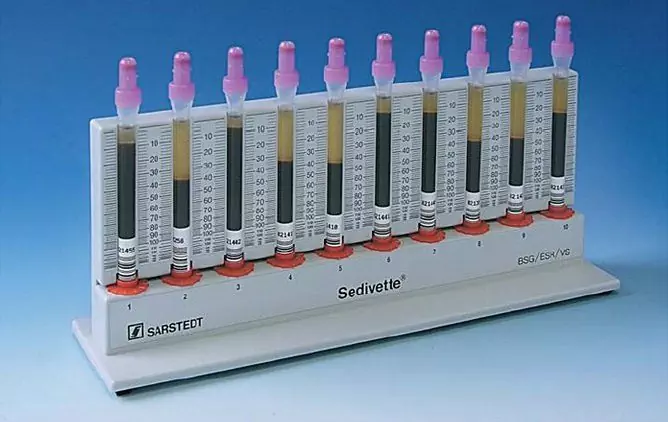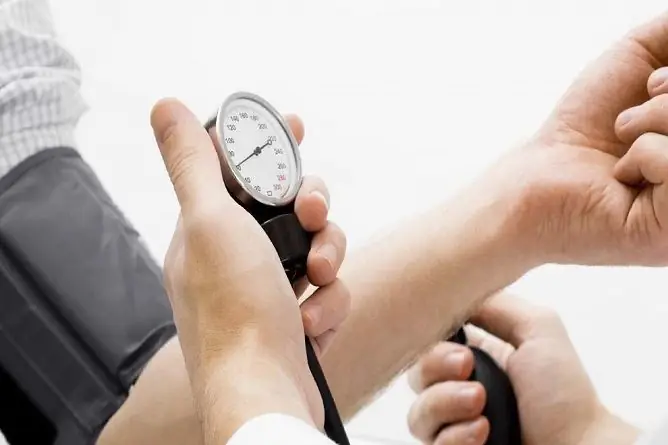- Author Rachel Wainwright [email protected].
- Public 2023-12-15 07:39.
- Last modified 2025-11-02 20:14.
WBC in the blood test: transcript, the norm in women and men
The content of the article:
- What is WBC Blood Test?
- Blood test for WBC: transcript, the norm in women, men and children
- An increase in WBC in a blood test - what does it mean?
- Causes of low WBC levels in a blood test
- Types of WBC in a blood test: norm and significance
WBC in a blood test is one of its main components. Determination of this indicator allows you to confirm or, conversely, exclude various diseases, as well as monitor the course of therapy. The abbreviation WBC is unfamiliar to most patients, so we will decipher it in detail.
What is WBC Blood Test?
General (clinical) blood test - a type of laboratory study aimed at quantifying blood cells (leukocytes, erythrocytes, platelets), as well as their specific indicators (ESR, hemoglobin), the number and percentage of different types of leukocytes (neutrophils, monocytes, lymphocytes, basophils and eosinophils).

A blood test for WBC is one of the basic tests used in the diagnosis of many diseases.
Indicators of a general blood test are usually denoted by the following abbreviations from English words:
- RBC (red blood cells) - the number of red blood cells or erythrocytes;
- HGB (hemoglobin, Hb) - the concentration of hemoglobin in a certain volume of whole blood;
- MCV - the average volume of one erythrocyte (previously this indicator was referred to as normo-, micro- or macrocytosis);
- HCT (Ht, hematocrit) - the ratio of the volume of erythrocytes, leukocytes and platelets, that is, formed elements to the volume of blood plasma;
- PLT (platelets) - the number of platelets (platelets);
- WBC (white blood cells) - the number of white blood cells (leukocytes).
Thus, a WBC blood test means counting the number of leukocytes.
Blood test for WBC: transcript, the norm in women, men and children
The main function of WBC cells, that is, leukocytes, is to protect the body from pathogenic microorganisms (viruses, bacteria, fungi), as well as foreign agents - cells and proteins. Therefore, WBC in a blood test is an indicator of inflammatory, infectious, allergic, and sometimes tumor processes. The main indications for its appointment:
- diseases of an infectious and inflammatory nature;
- persistent increase in body temperature;
- frequent headache;
- persistent pain in bones and joints;
- suspicion of malignant diseases of the hematopoietic system;
- dysfunction of the immune system;
- monitoring the effectiveness of the therapy.
In most cases, a biochemical blood test is prescribed simultaneously with the general one.
Determining the amount of WBC in the blood has an important diagnostic value and allows you to make a correct diagnosis in time. Normally, in adults, both men and women, 1 liter of blood contains 4-8.8x10 9 white blood cells. In children, the number of leukocytes in the blood is higher, which is explained by the immaturity of their immune system. The norm of leukocytes for children of different ages is presented in the table:
| Age | The number of leukocytes, x109 / l |
|
Children of the first month of life |
5.5-12.5 |
| 1 to 12 months | 6-12 |
| 1 to 6 years old | 5-12 |
| 7 to 12 years old | 4.5-10 |
| 13 to 15 years old | 4.3-9.5 |
An increase in WBC in a blood test - what does it mean?
A condition when a patient has an increase in the level of leukocytes in the blood is called leukocytosis. Its identification does not always indicate the presence of any disease. In some cases, leukocytosis can be physiological in nature and occur against the background of pregnancy, physical exertion, psycho-emotional stress, abundant food, overheating or hypothermia. That is why it is recommended to take a WBC blood test in the morning, after a full night's rest and on an empty stomach.
A significant increase in WBC in the blood may indicate a number of diseases, most often caused by bacterial microflora:
- respiratory tract infections;
- otitis;
- sinusitis;
- tonsillitis;
- acute or chronic in the stage of exacerbation of pancreatitis, cholecystitis;
- abscess, phlegmon;
- appendicitis;
- peritonitis;
- diseases of the kidneys and urinary tract (pyelonephritis, cystitis);
- gynecological infectious and inflammatory diseases (endometritis, adnexitis, pelvioperitonitis);
- purulent arthritis;
- osteomyelitis;
- sepsis.
In most cases, an increase in the WBC level is combined with the appearance of symptoms of general intoxication, which include:
- general weakness;
- decreased appetite;
- headache;
- pain in muscles and joints;
- increased body temperature.
Another cause of leukocytosis is malignant neoplasms. In the initial stages of cancer development, the patient's immune system tries to destroy it, which leads to an increase in the number of leukocytes in the blood. However, in the future, the body's reserves are depleted, cancer intoxication grows, metastases to the bone marrow occur. At this stage, the number of white blood cells in the blood decreases, leukopenia sets in - a condition opposite to leukocytosis.
Causes of low WBC levels in a blood test
A decrease in the number of leukocytes in the blood below normal physiological values is called leukopenia. This condition usually indicates a decreased immune response. The reasons for its occurrence:
- immunosuppressive therapy;
- leukemia;
- hypoplastic anemia;
- viral infections (viral hepatitis, rubella, measles, flu);
- systemic lupus erythematosus and other long-term systemic diseases;
- radiation sickness;
- chronic intoxication.
WBC in the blood can be lowered against the background of long-term depressive conditions, starvation.
Types of WBC in a blood test: norm and significance
When performing a general blood test, it is usually carried out not only to count the total number of leukocytes, but also to determine the percentage of their main subpopulations.
The percentage of different types of leukocytes is called the leukocyte formula. Her research plays an important role in the diagnosis of inflammatory, infectious and hematological diseases, in assessing the severity of the patient's condition and the effectiveness of the therapy.
By morphological and functional characteristics, the following types of WBC are distinguished:
- neutrophils;
- lymphocytes;
- monocytes;
- eosinophils;
- basophils;
- plasma cells.
With a severe course of the pathological process, immature forms of leukocytes begin to appear in the peripheral blood (blast forms, promyelocytes, myelocytes, young).

Leukocyte formula determines the ratio of different types of leukocytes
The most numerous group of WCDs are neutrophils - they account for 50 to 75% of the total number of white blood cells. According to the peculiarities of the structure of the nucleus, they are subdivided into segmented and stab. The main function of neutrophils is to protect the body from infectious agents by chemotaxis and phagocytosis. Neutrophilia, that is, an increase in the level of neutrophils in the blood, is observed under the following conditions:
- bacterial infections;
- inflammatory processes (pneumonia, otitis media, pancreatitis, pyelonephritis, endometritis);
- early postoperative period;
- oncological diseases in the early stages;
- ischemic tissue necrosis.
A decrease in the number of neutrophils (neutropenia) is caused by:
- viral infections;
- thyrotoxicosis;
- therapy with cytostatics, some antibiotics.
Lymphocytes provide immune surveillance, form and regulate cellular and humoral immunity, provide the body's immune memory. They account for approximately 20-40% of the total number of WCDs. An increase in the number of lymphocytes (lymphocytosis) is observed in infectious diseases (cytomegalovirus infection, viral hepatitis, infectious mononucleosis), diseases of the blood system and therapy with certain groups of drugs. The reasons for a decrease in the number of lymphocytes (lymphocytopenia) can be:
- immunodeficiency;
- lymphogranulomatosis;
- miliary tuberculosis;
- X-ray therapy.
Eosinophils are involved in the development of allergic reactions. Normally, their content in the blood is 1-5% of the total number of leukocytes. An increase in the number of eosinophils (eosinophilia) occurs against the background of allergic sensitization, which forms, for example, against the background of helminthic invasion.
The largest cells among leukocytes are monocytes. They have the ability to amoeba-like movement, phagocytic activity. Normally, monocytes account for 3-9% of the total number of leukocytes. Most often, monocytosis is caused by:
- acute and subacute endocarditis;
- Infectious mononucleosis;
- brucellosis;
- syphilis;
- tuberculosis;
- blood diseases;
- rheumatoid arthritis;
- systemic lupus erythematosus.
With hypoplasia of hematopoietic germs, the number of monocytes decreases, which leads to the development of monocytopenia.
Basophils are actively involved in inflammatory and allergic cellular reactions. Their content in the blood is normally no more than 0.5% of the total number of white blood cells. An increase in the number of basophils is observed in patients with hypothyroidism, lymphogranulomatosis, chronic myeloid leukemia, and also during estrogen therapy.
YouTube video related to the article:

Elena Minkina Doctor anesthesiologist-resuscitator About the author
Education: graduated from the Tashkent State Medical Institute, specializing in general medicine in 1991. Repeatedly passed refresher courses.
Work experience: anesthesiologist-resuscitator of the city maternity complex, resuscitator of the hemodialysis department.
Found a mistake in the text? Select it and press Ctrl + Enter.






